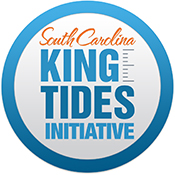2025 Predicted King Tides
- March 30
- April 26-29
- May 25-27
- October 7-11
- November 4-9
- December 3-6
King Tides - You Can Help!
SCDES is leading the South Carolina King Tides initiative to document the effect that extreme tide events have on our state's beaches, coastal waterways, private property and public infrastructure.

The term "King Tide" is a non-scientific term used to describe the highest seasonal tides that occur each year. For example, in Charleston, the average high tide range is about 5.5 ft., whereas during a King Tide event the high tide range may reach 7 ft. or higher. These tides occur naturally and are typically caused when a spring tide (when the sun, moon, and earth align during a new and full moon, increasing tide ranges) takes place when the moon is closest to Earth during the 28-day elliptical orbit (known as perigee).
The effect of individual King Tides may vary considerably. In some cases, they may barely even be noticed. In other cases, a King Tide may cause coastal erosion, flooding of low-lying areas and disruption to normal daily routines. This is particularly true when a King Tide event coincides with significant precipitation because water drainage and runoff is impeded. Over time, the frequency and effect of King Tide events may increase due to gradual mean sea level rise.
Get Involved
SCDES needs your help to capture photographs of King Tide events. Please refer to the SCDES Tide Chart for predicted dates and times and then use our mobile app on MyCoast: South Carolina to submit pictures from your smart phone.
SCDES will evaluate your photographs and include them in long-term analysis of coastal vulnerability and planning initiatives with municipalities. SCDES may also use your photographs in presentations, publications, and on its website.
Tips for Effective King Tides Photos
- Take pictures at or near peak high tide.
- Take pictures where the impact of the tide can be gauged against familiar landmarks like buildings, roads, sidewalks, parking lots, jetties, bridges, sea walls, shorelines, or bulkheads.
- Taking contrasting shots of peak high and peak low tides helps to show the tidal variability.
- Be Safe! Use good judgment when you are taking your photos. Stay away from dangerous situations particularly in stormy conditions and avoid taking risks.
Background
The King Tides Initiative is an international, public engagement program spreading to coastal areas throughout the United States and abroad. The initiative began in Australia in 2009, to encourage the public to photo-document the highest seasonal tides (dubbed "King Tides" at that time) they had seen in almost 20 years. They received over 2,000 photos. Interests in the program soon spread to the west coast of North America where British Columbia, Washington, Oregon, and California began King Tides Initiatives. The east coast has now joined the effort. Regional initiatives on the east coast include the Gulf of Maine King Tides Project. State-based initiatives are operating in Massachusetts, Connecticut, Maine, New Hampshire, Rhode Island, North Carolina, and South Carolina. The living photo records collected through these programs can help our communities visualize the impact of rising sea level or storm surge along low-lying areas, raise public awareness about coastal hazards, and support scientific research and planning.
- Interactive Story Map - The King Tides Project: Snap the Shore, See the Future
Definitions
- Syzygy - Alignment of the sun, moon, and Earth, which happens during the new and full moon phases.
- Spring Tides - The effects of syzygy that increase tidal force and cause tides to range significantly.
- Perigee - Occurs when the moon reaches the closest point to Earth during the 28-day elliptical orbit.
- Perigean Spring Tide - Occurs when the moon is closest to Earth during a spring tide.
For more information on the South Carolina King Tides Program, please contact Adam Bode.

